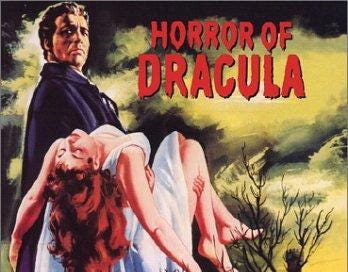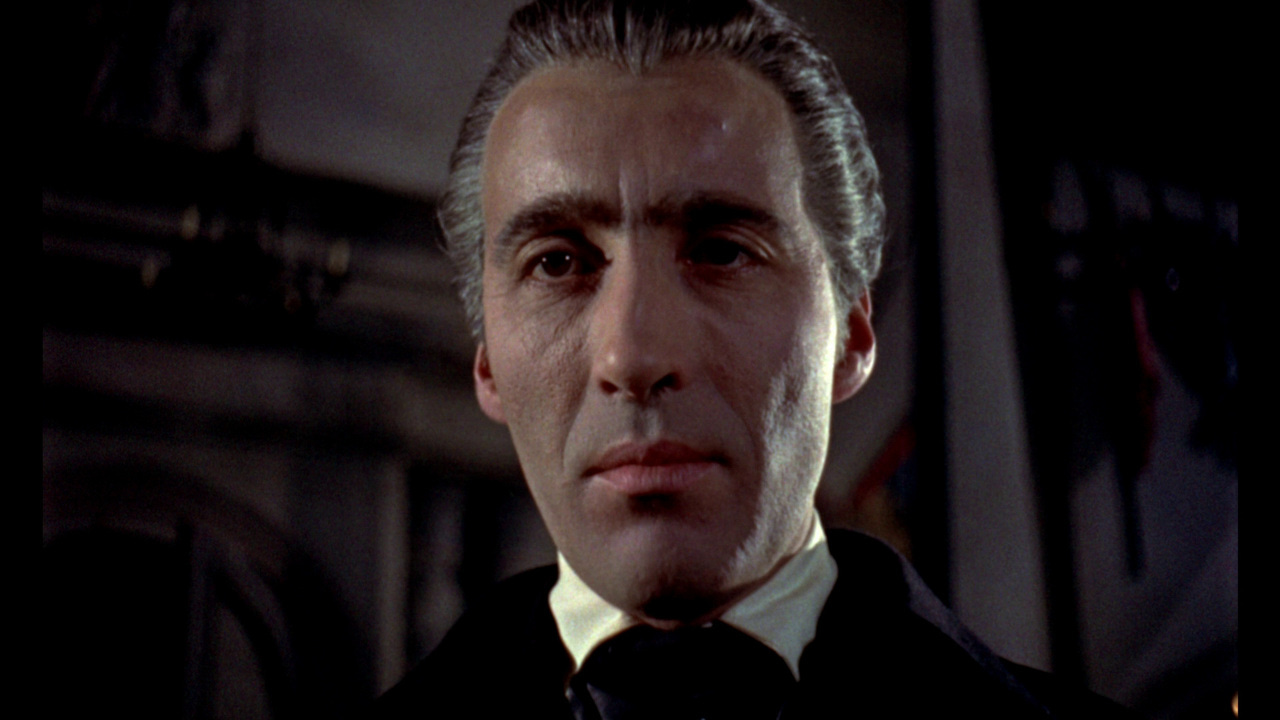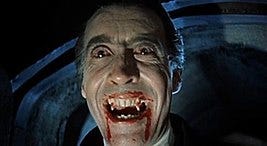Dracula (1958) is also known as The Horror of Dracula, the title it was released under in the US for fear of legal entanglements with the famous 1931 version. This one became quite famous in its own right, though: one of the Hammer studio’s famous horror pics, it’s the first portrayal of the Count by Christopher Lee, and the first pairing of Lee with Peter Cushing, who plays Van Helsing.
There’s a great irony in Lee’s depiction of Dracula, because of all the Dracula films I’ve watched, this is the only one in which, at the beginning, Dracula behaves like a normal person. Lee’s Dracula greets Jonathan Harker at his castle with a polite, “Hello, Mr Harker, how are you, pleasant journey?” and so forth. He is slightly weird because he’s wearing a cape, but he is very much just an ordinary and very polite gentleman wearing a cape. Unlike most film Draculas, this one, when in a position where he wishes to convince a stranger that he is just a normal guy, behaves like a normal guy. As opposed to other interpretations, who tend to behave like…well, like creepy vampires.
The irony comes in because, while Dracula is doing a great job of acting like an ordinary man, this is the one adaptation in which the guy he’s talking to already knows that he is a vampire. For whatever reason, writer Jimmy Sangster decided that Jonathan Harker would not be an innocent solicitor or real estate agent who knows not what he is blundering into at Castle Dracula. Here, Harker is Van Helsing’s vampire-hunting associate, and he has taken a job as Dracula’s librarian specifically for the purpose of killing the vampire and ending his reign of terror.
This is quite a twist on the usual narrative, and creates what you might call a plot hole, or at least an instance of that common movie affliction: a writer who doesn’t know how to get from Point A to Point B without making a character inexplicably lose his brain.
Because you see, Harker has come to Castle Dracula expressly to destroy the Count. And though he has been bitten and knows he may soon become a vampire himself, he still has an opportunity to complete his task, when he comes upon Dracula sleeping in his coffin. At this point, obviously, Harker will stake Drac and all will be well.
But no! Instead, Harker - who has come to the crypt for the purpose of killing Dracula - wanders away from Dracula’s coffin, over to the other coffin in the room, which holds Dracula’s sexy young sidekick. He then proceeds to stake her first, which causes her to scream, which wakes up Dracula, and when Harker turns back to the Count’s coffin, it’s empty and Dracula has the jump on him. And so Dracula escapes, Harker becomes a vampire, and later on Van Helsing has to stake him. All because Harker fell victim to that terrible human frailty: bad writing.
I wouldn’t want to dwell on that, though, because overall, this Dracula is quite a satisfying one. As a cheap British production, it is a small and un-ambitious adaptation: there are no towering Gothic sets or grand Transylvanian vistas. The action itself is confined to quite a small area: the house of the Holmwoods is within a coach ride of Castle Dracula. Most of the movie looks a bit like The Importance of Being Earnest - it’s a very drawing-room kind of movie. Very English and very minor-key.
Incidentally, the fact that in this movie Harker is a vampire hunter from the start, and Arthur Holmwood is the surviving hero who works with van Helsing, makes me consider the ways in which Dracula movies flip and twist the character genealogies from the book. In Bram Stoker’s novel:
Jonathan Harker: young solicitor who travels to Transylvania, marries Mina.
Mina Harker: friend of Lucy Westenra, marries Jonathan.
Lucy Westenra: engaged to Arthur Holmwood.
Arthur Holmwood: wealthy aristocrat, engaged to Lucy.
Dr Seward: friend of Arthur and Quincey, in love with Lucy, runs the asylum which keeps Renfield.
Quincey P. Morris: American friend of Arthur and Seward, in love with Lucy.
Renfield: crazy nut in Seward’s asylum who worships Dracula.
Now, in the 1931 Dracula there is no Arthur or Quincey, Lucy has no paramour, and Dr Seward is Mina’s father. But in this, the 1958 version, Jonathan is engaged to Lucy, who is Arthur’s sister, Mina is married to Arthur, and Dr Seward only appears briefly to give extremely unhelpful medical advice. Renfield doesn’t appear at all. And there’s no Quincey. There’s hardly ever Quincey, except in Coppola’s movie, which…but we’ll get to that later in the week.
Anyway, yes, 1958’s Dracula is a stagey little piece, quaint but very appealing in its way, with a sort of romanticism in its unconvincing exteriors and extremely mannered mid-century English acting styles. The way that Carol Marsh, as Lucy, delivers her lines is so cut-glass and so old-school that it’s simultaneously wildly unrealistic and ineffably charming.
But as far as acting goes, this movie is really about two guys. Michael Gough is stock-standard upper-class twit as Arthur, and Melissa Stribling is perfectly fine as Mina (she doesn’t have a lot to do, but there’s probably more of Stoker’s practical-minded, intelligent Mina in this one than many others). It’s all just a sideshow, though, to Lee and Cushing.
Cushing is actually the star of the movie. Van Helsing sometimes get a raw deal in Dracula movies, his eccentricities getting over-played so he comes across like a loon or buffoon. But Cushing’s van Helsing is down to earth, determined yet compassionate, and a cool, calm, vampire killing machine. Like a heroic British colonel in a war film, he is in control at all times, even when things go tits-up, and his bravery and intelligence are never in question. He’s the kind of get-the-job-done hero you don’t really get in films anymore.
Lee has far less screen time, but makes the most of what he gets. All of his dialogue occurs in the opening scenes, when he welcomes Harker in the aforementioned friendly and normal manner. From then on, when he appears, he is silent, either snarling like a beast with bared canines and burning eyes, or looking upon his hapless female victims with triumphant menace. Lee does silent menace and wild savagery equally well. His overall look is based on Bela Lugosi’s from 1931, but he carved out a Dracula niche very nicely for himself by effectively embodying the Count.
It’s not, of course, very scary. It’s difficult to say whether it was scary in 1958 - Hammer horror was always notable for its camp value, and right from the start one suspects people were viewing these films as jolly romps more than real spine-tinglers. But hey, who knows - in the pre-Exorcist days maybe folk really were so innocent that drawing-room Dracula could chill them to the bone. Certainly Christopher Lee, when the camera goes in tight on his perfectly vampiric features, has the presence to unnerve, even if only for a moment. But overall the film has the vibe of a rousing, if small-scale, adventure yarn.
Interestingly this one goes the Nosferatu route of having Dracula vanquished by sunlight. It also introduces the generally non-canonical idea that you can repel a vampire with a crucifix even if the crucifix is just two long straight objects that you’ve held together in a cross shape. Which does have certain implications - vampires must get repelled purely by accident, surely.
Dracula can’t turn into a bat in this one, either. He can’t turn into anything, actually. Van Helsing specifically poo-poos the idea of vampires changing their form. “That’s a common fallacy,” he says with slightly snotty superiority. It’s probably a pretty wise move on Sangster and director Terence Fisher’s part: they knew that with their budget all they’d be able to manage would be a plastic bat on strings, like in the Lugosi film. Better to steer clear of bats altogether.
Dracula of 1958 veers extremely wide of the narrative of Stoker’s novel, and yet it manages to retain a real…let us call it Dracula-i-ness. This is a very Dracula-y film, and I think Stoker would have approved of the way it was composed, and particularly of the excellent job Cushing and Lee did of breathing life into the principal characters. Compare this to, say Coppola’s effort, which includes a lot more scenes from the book, but is much, much less Dracula-y, and which Stoker would’ve hated. But again, that’s for later. For now, I commend to you Dracula (1958) - perhaps not the best Dracula, but one of the most fun.







